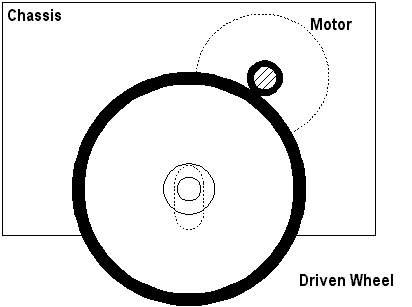
The robot is driven by a pair of 24 VDC motors, obtained surplus. Originally, they were used as servo reel motors for a computer tape drive (because they had the hubs and locking flanges to hook onto a standard 1/2" reel when I got them). They spin approximately 800 RPM at 12V, with no load. Twice that with 24V.
Rather than work out some sort of gearing or chain drive, I used a technique I had used in the past, friction driving a larger wheel. I put a piece of 1/2" ID rubber hose over the 1/2" shaft of the motor, producing a rubber coated drive shaft about 3/4" in diameter. This presses against a standard 5" (12-13 cm) rubber tired wheel with ball bearings running on a 1/2" shaft which slides in a vertical slot. Small springs force the axle up against the drive roller. The photo and diagram below illustrate this (the short bars are 1cm long). At 1200 RPM and a drive roller diameter of 2cm, the ground speed will be approximately = pi*2*20 cm/sec, or 1.2 m/sec, which is faster than a walk, but you can still out run it; For instance, if the software has a bug, or a drive amplifier fails full ON, and the robot runs away, and you need to catch it.
 |
|
|
The motors are fairly bulky (about 15 cm long), so they are mounted side by side, with each one having a shaft protrude through the side of the chassis. In the photo at right, you can see the shaft of the lower motor protruding to the left. Conveniently, the motors are almost exactly the same length as a 12V sealed lead acid battery, one each of which is mounted under each motor. As before, small bars are 1cm long, long bars are 5 cm. The orange object is a RC electronic speed control (ESC) used in testing. |